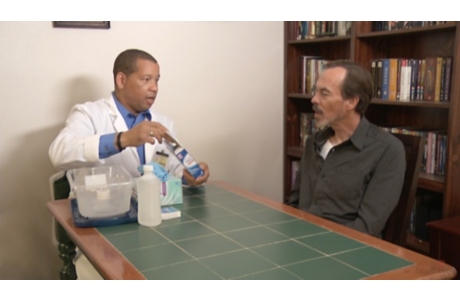Leukemia
Condition Basics
What is leukemia?
Leukemia is cancer of the blood cells. It starts in the bone marrow, the soft tissue inside most bones. Bone marrow is where blood cells are made.
- White blood cells help your body fight infection.
- Red blood cells carry oxygen to all parts of your body.
- Platelets help your blood clot.
When you have leukemia, the bone marrow starts to make a lot of abnormal white blood cells, called leukemia cells. They don't do the work of normal white blood cells. They grow faster than normal cells, and they don't stop growing when they should.
Over time, leukemia cells can crowd out the normal blood cells. This can lead to serious problems such as anemia, bleeding, and infections. Leukemia cells can also spread to the lymph nodes or other organs and cause swelling or pain.
Are there different types of leukemia?
There are several different types of leukemia. In general, leukemia is grouped by how fast it gets worse and what kind of white blood cell it affects.
- It may be acute or chronic. Acute leukemia gets worse very fast and may make you feel sick right away. Chronic leukemia gets worse slowly and may not cause symptoms for years.
- It may be lymphocytic or myeloid. Lymphocytic (or lymphoblastic) leukemia affects white blood cells called lymphocytes. Myeloid leukemia affects white blood cells called granulocytes and monocytes. The four main types of leukemia are:
- Acute lymphoblastic leukemia, or ALL.
- Acute myeloid leukemia, or AML.
- Chronic lymphocytic leukemia, or CLL.
- Chronic myeloid leukemia, or CML.
There are less common leukemias, such as hairy cell leukemia. There are also subtypes of leukemia, such as acute promyelocytic leukemia (a subtype of AML).
What causes it?
Experts don't know what causes leukemia in most people. But they think that most leukemia happens because of things in the environment and in a person's genes.
Some things may increase the risk, such as having certain genetic conditions or being exposed to large amounts of radiation or certain chemicals.
What are the symptoms?
Symptoms of acute leukemia depend on how much the cancer has grown. They may include:
- A new lump or swollen gland in your neck, under your arm, or in your groin.
- Frequent nosebleeds, bleeding from the gums or rectum, more frequent bruising, or very heavy menstrual bleeding.
- Frequent fevers.
- Night sweats.
- Bone pain.
- Unexplained appetite loss or recent weight loss.
- Feeling tired a lot without a known reason.
- Swelling and pain on the left side of the belly.
The chronic forms of leukemia often cause no symptoms until much later in the disease. And when symptoms appear, they usually appear gradually.
How is it diagnosed?
The doctor will ask about your past health and family history. Your doctor will do a physical exam and order blood tests. Imaging tests may be done. A bone marrow aspiration and biopsy will likely be done. Depending on the results, more tests may be needed to learn more about the type of leukemia.
How is leukemia treated?
Treatment for leukemia is based on the type of leukemia, whether it has spread, and other things such as your overall health. Treatment options may include:
- Chemotherapy and other medicines.
- Chemotherapy medicines kill fast-growing cells, including cancer cells and some normal cells.
Other medicines may be given to help chemotherapy work better and prevent infection or bleeding. Examples include steroids and antibiotics.
- Radiation therapy.
-
This uses high-dose X-rays to destroy cancer cells and shrink tumors.
- Stem cell transplant.
- This replaces damaged cells with healthy stem cells. They help your bone marrow make healthy blood cells.
- Targeted therapy.
- These medicines target cancer cells. They help keep cancer from growing or spreading.
- Immunotherapy.
- This treatment helps your immune system fight cancer. It may be given in several ways.
Sometimes a clinical trial may be a good choice.
Your doctor will talk with you about your options and then make a treatment plan.
Health Tools
Health Tools help you make wise health decisions or take action to improve your health.
Related Information
Credits
Current as of: October 25, 2024
Author: Ignite Healthwise, LLC Staff
Clinical Review Board
All Ignite Healthwise, LLC education is reviewed by a team that includes physicians, nurses, advanced practitioners, registered dieticians, and other healthcare professionals.
Current as of: October 25, 2024
Author: Ignite Healthwise, LLC Staff
Clinical Review Board
All Ignite Healthwise, LLC education is reviewed by a team that includes physicians, nurses, advanced practitioners, registered dieticians, and other healthcare professionals.







